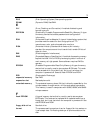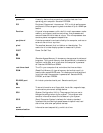
3
Glossary
DOS (Disk Operating System) See operating system.
DRAM (Dynamic RAM) See RAM.
E
ECC (Error Checking and Correction) A method of detecting and
correcting errors.
EEPROM (Electrically Erasable Programmable Read-Only Memory) A type
of memory device that stores password and configuration
information.
EGA (Enhanced Graphics Adapter) A type of video display system that
provides medium-resolution text and graphics on TTL
monochrome, color, and enhanced color monitors.
EISA (Extended Industry Standard Architecture) An industry
standard for computers and circuit cards that transfer 32 bits of
data at a time.
EMI (Electromagnetic Interference).
EMS (Expanded Memory Specification) A method of accessing memory
beyond the 640K limit of DOS by exchanging data in and out of
main memory at high speeds. Some software requires EMS to
operate.
EPROM (Erasable Programmable Read-Only Memory) A type of memory
device that is usually used to store system BIOS code. This code
can be erased with ultraviolet light, but is not lost when the
computer is powered off. See also flash EPROM and ROM.
ESD (Electrostatic Discharge).
expanded memory See EMS.
expansion slot See backplane slot.
extended memory The protected memory above 1M that is directly accessible by the
microprocessor through certain utilities and operating systems.
This memory is used in computers with 80286, 80386, and 80486
microprocessors.
F
flash EPROM A type of memory device that is usually used to store system
BIOS code. This code can be replaced with updated code from a
floppy disk, but is not lost when the computer is powered off. See
also EPROM and ROM.
floppy disk drive See disk drive.
format The process used to organize a hard or floppy disk into sectors so
it can accept data. Formatting destroys all previous data on the
disk.


















